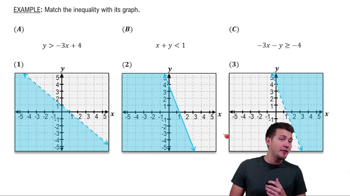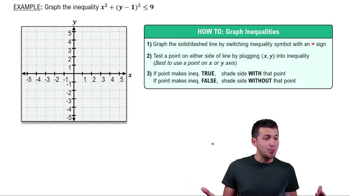Table of contents
- 0. Review of Algebra4h 16m
- 1. Equations & Inequalities3h 18m
- 2. Graphs of Equations43m
- 3. Functions2h 17m
- 4. Polynomial Functions1h 44m
- 5. Rational Functions1h 23m
- 6. Exponential & Logarithmic Functions2h 28m
- 7. Systems of Equations & Matrices4h 6m
- 8. Conic Sections2h 23m
- 9. Sequences, Series, & Induction1h 19m
- 10. Combinatorics & Probability1h 45m
7. Systems of Equations & Matrices
Graphing Systems of Inequalities
Problem 25b
Textbook Question
In Exercises 1–26, graph each inequality. y≥log_2(x+1)
 Verified step by step guidance
Verified step by step guidance1
Step 1: Understand the inequality y \geq \log_2(x+1). This represents the region on the graph where the y-values are greater than or equal to the logarithmic function \log_2(x+1).
Step 2: Identify the domain of the function \log_2(x+1). Since the logarithm is only defined for positive arguments, x+1 > 0, which implies x > -1.
Step 3: Graph the boundary line y = \log_2(x+1). This is the curve that separates the region where the inequality holds from where it does not. The graph of \log_2(x+1) is a logarithmic curve that passes through the point (0, 0) and approaches negative infinity as x approaches -1 from the right.
Step 4: Determine the region to shade. Since the inequality is y \geq \log_2(x+1), shade the region above the curve y = \log_2(x+1). This includes the curve itself because of the 'greater than or equal to' part of the inequality.
Step 5: Check a test point. Choose a point not on the boundary, such as (0, 1), and substitute it into the inequality to verify it satisfies y \geq \log_2(x+1). If it does, the shading is correct; if not, adjust accordingly.
Recommended similar problem, with video answer:
 Verified Solution
Verified SolutionThis video solution was recommended by our tutors as helpful for the problem above
Video duration:
6mPlay a video:
Was this helpful?
Key Concepts
Here are the essential concepts you must grasp in order to answer the question correctly.
Inequalities
Inequalities are mathematical expressions that show the relationship between two values when they are not equal. They use symbols such as '≥' (greater than or equal to) and '≤' (less than or equal to) to indicate the range of possible solutions. Understanding how to interpret and graph inequalities is essential for visualizing the solutions on a coordinate plane.
Recommended video:

Linear Inequalities
Logarithmic Functions
Logarithmic functions, such as log_2(x+1), are the inverses of exponential functions. They express the power to which a base must be raised to obtain a certain value. In this case, log_2(x+1) indicates the exponent to which 2 must be raised to yield (x+1). Familiarity with the properties and behavior of logarithmic functions is crucial for accurately graphing them.
Recommended video:

Graphs of Logarithmic Functions
Graphing Techniques
Graphing techniques involve plotting points and understanding the shape of functions on a coordinate plane. For inequalities, it is important to determine the boundary line (in this case, y = log_2(x+1)) and then shade the appropriate region that satisfies the inequality. Mastery of these techniques allows for effective visualization of solutions and their relationships.
Recommended video:
Guided course

Graphs and Coordinates - Example

 7:2m
7:2mWatch next
Master Linear Inequalities with a bite sized video explanation from Patrick Ford
Start learning





